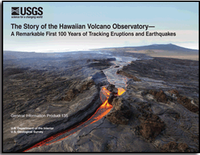The year 2012 marks the centennial of the Hawaiian Volcano Observatory (HVO). With the support and cooperation of visionaries, financiers, scientists, and other individuals and organizations, HVO has successfully achieved 100 years of continuous monitoring of Hawaiian volcanoes. As we celebrate this milestone anniversary, we express our sincere mahalo—thanks—to the people who have contributed to and participated in HVO’s mission during this past century. First and foremost, we owe a debt of gratitude to the late Thomas A. Jaggar, Jr., the geologist whose vision and efforts led to the founding of HVO. We also acknowledge the pioneering contributions of the late Frank A. Perret, who began the continuous monitoring of Kīlauea in 1911, setting the stage for Jaggar, who took over the work in 1912. Initial support for HVO was provided by the Massachusetts Institute of Technology (MIT) and the Carnegie Geophysical Laboratory, which financed the initial cache of volcano monitoring instruments and Perret’s work in 1911. The Hawaiian Volcano Research Association, a group of Honolulu businessmen organized by Lorrin A. Thurston, also provided essential funding for HVO’s daily operations starting in mid-1912 and continuing for several decades. Since HVO’s beginning, the University of Hawaiʻi (UH), called the College of Hawaii until 1920, has been an advocate of HVO’s scientific studies. We have benefited from collaborations with UH scientists at both the Hilo and Mänoa campuses and look forward to future cooperative efforts to better understand how Hawaiian volcanoes work. The U.S. Geological Survey (USGS) has operated HVO continuously since 1947. Before then, HVO was under the administration of various Federal agencies—the U.S. Weather Bureau, at the time part of the Department of Agriculture, from 1919 to 1924; the USGS, which first managed HVO from 1924 to 1935; and the National Park Service from 1935 to 1947. For 76 of its first 100 years, HVO has been part of the USGS, the Nation’s premier Earth science agency. It currently operates under the direction of the USGS Volcano Science Center, which now supports five volcano observatories covering six U.S. areas—Hawaiʻi (HVO), Alaska and the Northern Mariana Islands (Alaska Volcano Observatory), Washington and Oregon (Cascades Volcano Observatory), California (California Volcano Observatory), and the Yellowstone region (Yellowstone Volcano Observatory). Although the National Park Service (NPS) managed HVO for only 12 years, HVO has enjoyed a close working relationship with Hawaiʻi Volcanoes National Park (named Hawaii National Park until 1961) since the park’s founding in 1916. Today, as in past years, the USGS and NPS work together to ensure the safety and education of park visitors. We are grateful to all park employees, particularly Superintendent Cindy Orlando and Chief Ranger Talmadge Magno and their predecessors, for their continuing support of HVO’s mission. HVO also works closely with the Hawaiʻi County Civil Defense. During volcanic and earthquake crises, we have appreciated the support of civil defense staff, especially that of Harry Kim and Quince Mento, who administered the agency during highly stressful episodes of Kīlauea's ongoing eruption. Our work in remote areas on Hawaiʻi’s active volcanoes is possible only with the able assistance of Hawaiʻi County and private pilots who have safely flown HVO staff to eruption sites through the decades. A special mahalo goes to David Okita, who has been HVO’s principal helicopter pilot for more than two decades. Many commercial and Civil Air Patrol pilots have also assisted HVO by reporting their observations during various eruptive events. Hawaiʻi’s news media—print, television, radio, and online sources—do an excellent job of distributing volcano and earthquake information to the public. Their assistance is invaluable to HVO, especially during times of crisis. HVO’s efforts to provide timely and accurate scientific information about Hawaiian volcanoes and earthquakes succeed only because of you, our receptive and keenly aware public. By following the activity of Hawaiʻi’s active volcanoes through our daily eruption updates posted on the HVO website, viewing HVO webcam images, reading our weekly “Volcano Watch” articles, and attending our public lectures, you help us to ensure that you can live safely with Hawaiʻi’s dynamic volcanoes. To everyone who has shared in HVO’s reaching this milestone—100 years of continuous volcano monitoring—we extend our deepest gratitude. Mahalo nui loa!


